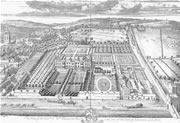LOST BUILDINGS OF INFLUENCE
External Partner: English Heritage, Newcastle
Architectural history studies are sometimes clouded by the uncertainties of important buildings that have been lost to us, often without record. Consequently the influence they may have exerted on a town, region or country cannot be assessed. But research into lost buildings can frequently reveal rich details that can illuminate architectural development and fill-in the missing links in an architectural narrative. (for example, Romanesque architectural studies advanced with Kenneth Conant’s archival and archaeological examination of the great Romanesque churches, now gone.) .
Newcastle was a major urban centre and the buildings constructed here, commissioned by a powerful and wealthy elite, would have influenced architectural and garden design throughout the region.
Undergraduate research might focus on a single building in the list below: post-graduate work could involve a collective study of these lost houses
- Anderson Place: a well-known, but little researched historic building.
- The Mansion House, The Close: an important seventeenth century public building.
- Westmorland House, Neville Street: an Elizabethan structure preserved in at least one enigmatic photograph. Is it the pre-1569 town house of the wealthy Earls of Westmorland?
- Cosyn’s House, Quayside: a richly decorated merchant’s house, demolished in 1896 or possibly as late as the 1920’s for the Tyne Bridge?
- Robert Trollope’s Guildhall, Sandhill: part of this surviving, and there are some illustrations, but what else could be gleaned?
|

|



